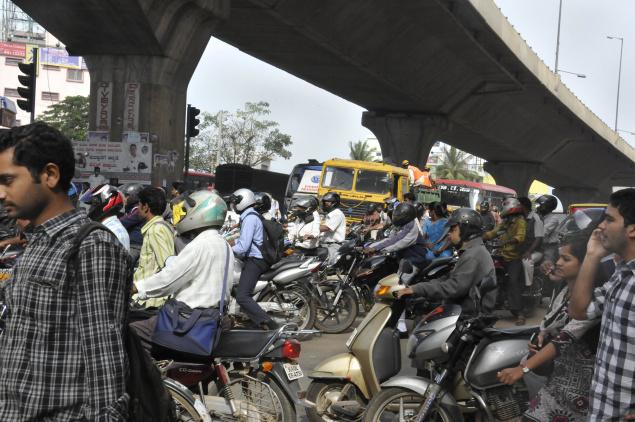BANGALORE, October 2: Rugged roads filled with potholes at every metre, and surrounded by debris thanks to the construction work taking place on one side. We start at 6.02 p.m. on a motorcycle at the C.N.R. Rao Circle, near the Indian Institute of Science.
The construction of the underpass, which connects Malleswaram and Mehkri Circle to Yeshwanthpur, was taken up in 2010 but several deadlines set for its completion have not been met.
After bracing the dust and the rugged road, we survive the roller-coaster ride. To our surprise, we find that the road wears a comparatively deserted look than what we have seen on other days.
With an eye on the clock, we head to Jalahalli Cross. As per the Google Maps projection, we are determined to reach Jalahalli Cross in 23 minutes.
We zoom on our motorcycle on the Pandit Deenadayala Upadhyaya flyover relatively easily and keep our figures crossed as we see a bird’s eye view of the motorbikes, buses, lorries and cars fighting for space below the flyover.
As we reach the end of the flyover and enter Tumkur Road, our smooth ride ends. The mighty lorries and buses dominate the swanky National Highway 4 that is not only the connecting road to north Karnataka and parts of coastal Karnataka, but also houses one of Asia’s largest industrial hubs — the Peenya Industrial Area.
It is around 6.30 p.m. on Tumkur Road and we are stuck amid the blaring horns of vehicles. We begin to quiz a disgruntled motorist who is stuck with us at a traffic signal near the Yeshwanthpur railway junction. “Consider yourself lucky. The traffic snarls and jams after 8 p.m. is enough to raise your blood pressure levels,” he says as he tries to manoeuvre between a lorry and a BMTC bus.
At the Yeshwanthpur railway junction, you can watch pedestrians armed with luggage reinventing signs to plead the motorists to allow them to cross the road.
As we move forward, it appears as though tempers increased as we moved every metre. At the Jalahalli Cross, a policeman armed with a stick was seen chasing a car that had stopped at the junction. After using his stick to hit the vehicle, he used his lung power to scare the motorist who was a few metres away.
The initial smooth ride turned helter-skelter with the huge traffic density and poor management of traffic after the Yeshwanthpur junction.
As we reached Jalahalli Cross, our 8.1-km journey finally ended in 51 minutes, which was more than two times that what Google Maps had projected. Our average speed was around 9.5 km an hour. Travelling uphill would have been faster than this. We failed to reach our destination with the stipulated time and were defeated by the traffic snarls.
But regular commuters on the road tell us to consider ourselves lucky, as they claim they usually take much longer to cover the same distance.
Our ride on Tumkur Road
Distance: 8.1 km
Time: 51 min
Peak hours: 8.30 a.m. to 10.30 p.m.; 6.30 p.m. to midnight
What commuters have to say
Sarfaraaz Khan, consultant engineer: There is always traffic pile-up on this junction as it is an industrial area and also a highway. The road is dominated by buses and lorries, cars and motorists have to fight for survival.
Snehal C.N.: The traffic police need to play a better role in managing the traffic. Unlike most other parts of the city, the roads here are comparatively better, the problem lies in traffic management. More traffic personnel should be deployed at the Yeshwanthpur railway junction.
What the experts have to say
B. Dayanand, Additional Commissioner of Police (Traffic): The sheer volume of traffic has increased in this area. Once the work on the underpass at C.N.R Rao junction is complete, it will help ease traffic congestion. In industrial areas, there is pile-up only during peak hours and can be managed by traffic authorities.

